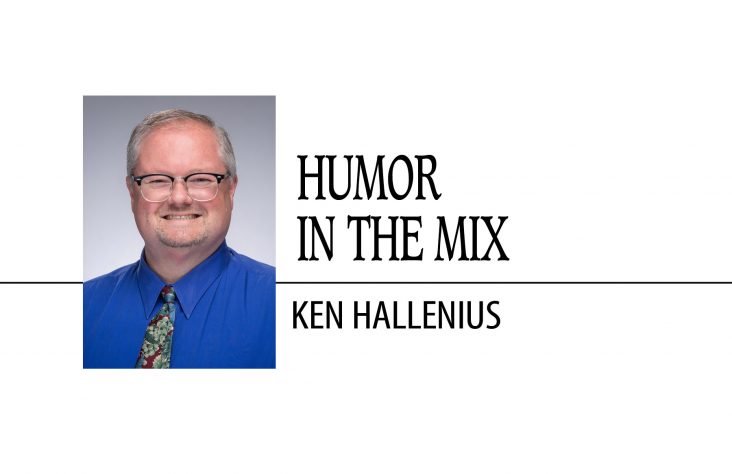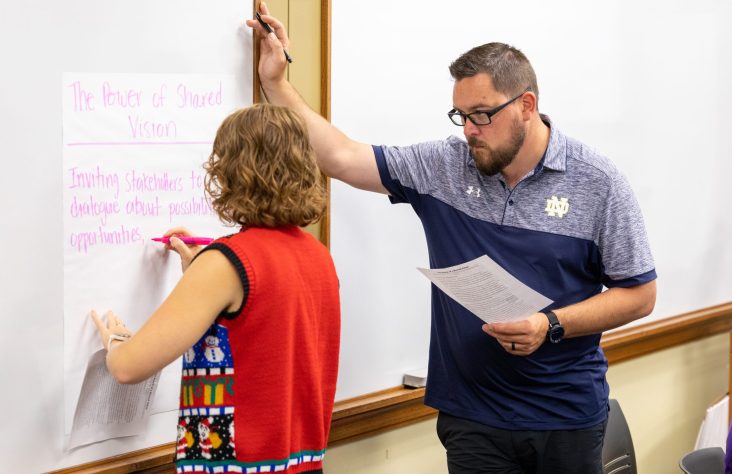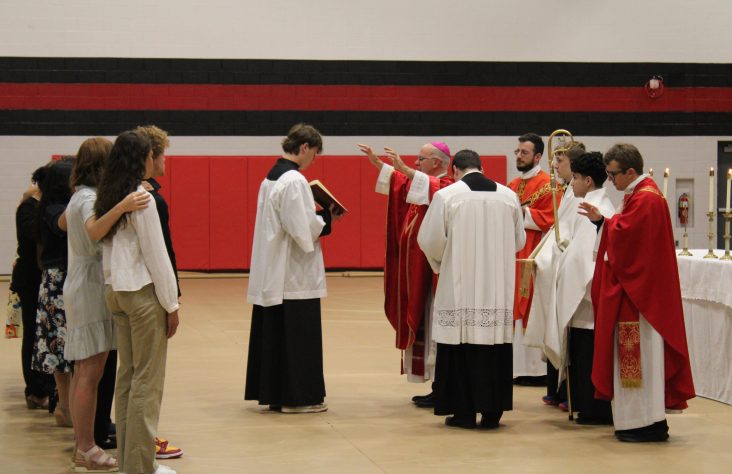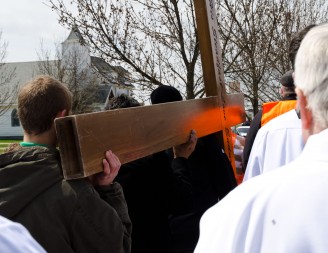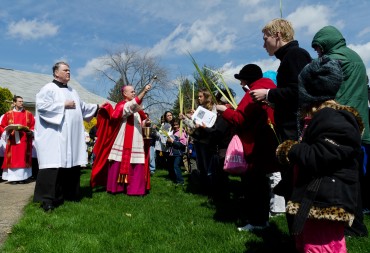April 20, 2011 // Local
Six-Church Passion Walk, a day of retreat for diocese
Click here for more photos of the walk
By Laurie Kiefaber
SOUTH BEND — The Six-Church Passion Walk on Palm Sunday in South Bend was like a retreat for some and a pilgrimage for others, depending on shoes or a lack of them. Either way, most participants polled said it was a good way to prepare for Holy Week.
Approximately 100 to 175 people attended the walk at any one time, with some people participating in a few Stations of the Cross, but most taking on the entire walk. The sunny but cool and breezy day with a daytime high of 52 degrees brought together people from St. Joseph, St. Patrick, St. Hedwig, St. Augustine, St. Stanislaus and Holy Cross churches as well as those outside the area. Local police assisted walkers at intersections and a few golf carts were available to those who needed a break.
“Today was like a day of retreat for me with my people of the diocese,” said Bishop Kevin C. Rhoades after the Palm Sunday Mass at Holy Cross. “It was so prayerful and a wonderful way to begin Holy Week.”
Before the walk began, Bishop Rhoades talked about Jesus’ walk to Jerusalem when people walked with Him.
“We are spiritually united with them,” Bishop Rhoades said. “I thank you for being here.”
Most people wore sensible shoes for the event, with participants walking from one church to another between various stations. However, Gabriel Akre, 13, went the majority of the walk without his shoes.
“I’m giving up shoes for Lent,” said the home-schooled teen. “Last year during the fall 40 Days for Life (I also gave up shoes).”
The St. Pius X member said he was inspired by the Franciscan Brothers Minor who have gone barefoot before.
“It helps your faith grow,” he added. “It definitely toughens up my feet. … The Franciscans are really cool!”
His father, Tom Akre, said he was pleased he could participate barefoot, donning shoes inside the churches and public places.
“Sometimes doing something a little more extreme makes a statement and gets people to ask about it,” he said. “Hopefully, it will get people to think. God became flesh and (giving up shoes and other physical activities) make it more real.”
While inside each church, attendees were able to listen to beautiful meditations and prayers by Cardinal Camillo Ruini, vicar general emeritus of His Holiness for the Diocese of Rome, with permission. They also were educated on the history of each parish and the people who built it. St. Augustine was established in 1928 for black Catholics who had come to South Bend, according to Holy Cross Father Pastor Leonard Collins. Father George O’Connor was their first pastor.
“(O’Connor) was born in Kansas and a tornado wiped out his whole family,” Collins said. “A black family took him in.”
Before the church was built in 1941, Collins said black Catholics met at taverns. Cheryl Ashe, a St. Augustine member, said church was segregated back then and African Americans had to take Communion last. Before St. Augustine was built, some churches had a small room set up for them so they would not have to wait until the end, she said.
Ashe’s mother, Theresa, had been a social worker and she converted to the faith.
“She wanted to align herself with people who lived the Gospel,” Cheryl Ashe said.
When Theresa Ashe’s clients needed a donation for something, the Catholic priests did not ask if they were Catholic or attending Masses, as some ministers did, Cheryl Ashe explained.
“I thought (this walk) was nice,” Ashe said. “It showed the solidarity of all the city parishes. People think St. Augustine is dying, but it’s not. People may move away (to St. Joseph, Mich. or Buchanan, Mich.) but they still come back.
“The church has not abandoned (the local churches or people). That’s what Jesus was about. He didn’t abandon us,” she said.
Neighborhoods in the area are deteriorating, but the diocese still supports ministries such as soup kitchens and clothing donations for people, Ashe said.
Another St. Augustine member, Jonathan Jones, 17, was asked to help carry the hollow cross between several churches. “It was heavy,” he said. “My hands were freezing when we first started. It was a good experience. I did it a couple years ago (for a smaller event).”
Gary King, a St. Joseph member, said this was the first time he had been inside St. Augustine. An addition to the church was built about 20 years ago.
“There’s a good mix of people here,” King said. “I’m happy to see younger people participating in an old tradition. It’s a good witness (of faith) to see people walking through the streets of South Bend.”
John Sikorski was one of the younger people taking the walk with his wife and two small children — aged two and nine months.
“We wanted to instill the faith in them at a young age,” the St. Matthew Cathedral member said. “We were really excited the bishop wanted to bring this tradition to South Bend. It’s a beautiful experience what we’re doing in South Bend with the Universal Church. The bishop is the shepherd of the flock here.”
Sikorski also mentioned the walk was a powerful witness to non-Catholics who might be watching the procession.
Several order priests and nuns also participated in the walk. Friar Gerard, whose order has ties to Great Britain and Ireland and is serving an interim novitiate with the Mishawaka Franciscans, was snapping photos of the walk. “It’s a great way to prepare for Holy Week,” he said.
Sister Benedicta Duna, who had not yet professed her first vows with the Sisters of St. Francis of Perpetual Adoration in Mishawaka, enjoyed seeing all the people who came to share a prayerful beginning to Holy Week.
“It was neat seeing the different churches in South Bend I haven’t seen before,” she said. “It also was neat to see the bishop’s faith and understanding and making the event public for the people to see.”
Sister Mariana Collison, who has yet to profess her second vows in the same order, appreciated the experience. “It’s really powerful — walking,” she said. “It’s a time to meditate on the stations.
… People were watching us at the intersections … I identified with Him as He walked.”
At the St. Stanislaus grotto where palms were distributed, Bishop Rhoades talked about how Jesus took charge of even small details of His entry into Jerusalem on Palm Sunday and how He was different from other kings.
“Worldly kings rode horses,” Bishop Rhoades said. “The new King — meek and humble of heart — entered riding a donkey.”
Jeanine Celmer of Holy Cross and St. Stanislaus was among the walkers who said the rosary and sang songs at the beginning. “It’s such a beautiful idea,” she said. “I’ve never been on a walk (like this) and will never make it on a pilgrimage.”
College students such as Regina Slonkosky also were enjoying the day. “We’re giving witness and preparing for the triduum,” the liberal studies major at Holy Cross College in South Bend said in front of the grotto. “This is a great way to start Palm Sunday.”
Chris Gautsch, a University of Notre Dame student, saw his faith in the event. “It’s been great!” he said. “I really enjoyed celebrating with the bishop — Palm Sunday, the Lord’s Passion and following in the bishop’s steps. … Being here with the faith community of Catholics is another aspect of faith building.”
During his homily at Holy Cross Church, Bishop Rhoades said, “It’s important for us to focus on the crucifixion. It’s a horrendous way to die.”
Jesus endured mocking from people, having His clothes stripped away and nails being painfully hammered through His hands and feet, Bishop Rhoades said.
“Hanging on a cross He embraced every feeling of intense spiritual and physical suffering,” he continued. “He entered into complete solidarity (with man).”
The best news. Delivered to your inbox.
Subscribe to our mailing list today.


